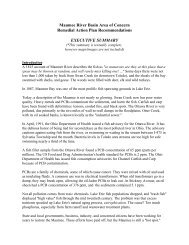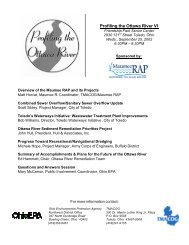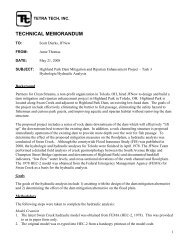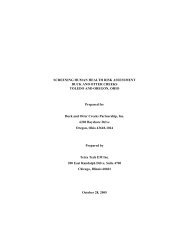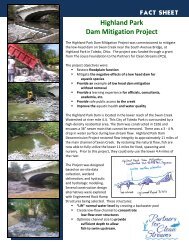Complete report - Partners for Clean Streams
Complete report - Partners for Clean Streams
Complete report - Partners for Clean Streams
Create successful ePaper yourself
Turn your PDF publications into a flip-book with our unique Google optimized e-Paper software.
Tyler Street Landfill (east end of Tyler St. near Creekside Ave., Toledo)<br />
Site History:<br />
The 77 acre Tyler St. Landfill was operated by the City of Toledo from the early 1950s<br />
to 1968. The City of Toledo used the site to dispose of up to 2200 cubic yards of<br />
municipal waste daily. Private parties also disposed of approximately 400 cubic yards<br />
of industrial/commercial waste daily. Wastes such as grease, oil, sewage organic<br />
materials, solvents, heavy metals, corrosives, paint wastes, municipal garbage, street<br />
sweepings and more were disposed in this landfill.<br />
The Ottawa River was rerouted to its present location and the original channel was<br />
filled with waste as the Tyler St. Landfill. After the landfill stopped accepting waste<br />
and was covered, the western portion of the property was used by Creekside Auto<br />
Parts as an automobile junkyard which was covered by soil and demolition debris.<br />
During this operation the land was leveled, cutting off part of the cap and exposing<br />
waste. The east side of the landfill was vegetated with several small ponds/marshes<br />
due to differential settling of the landfill waste materials. Leachate was discharging<br />
from the landfill into the river in several places and the landfill had severely eroded<br />
along the riverbanks until remediation.<br />
Site Investigation (1984-1986)<br />
Sampling studies done in 1984 and 1986 by the Ohio EPA and the City of Toledo<br />
documented contaminant levels in the landfill soils and leachate high enough to<br />
warrant further action under the Superfund program.<br />
(1993-1995)<br />
In 1993 an Expanded Site Inspection (ESI) at Tyler by US EPA documented the<br />
existence of drainage pipes from within the landfill discharging directly into the<br />
riverbank and into the river. Samples of the leachate and soil showed elevated levels<br />
of heavy metals, volatile and semi-volatile organic compounds, and PCBs.<br />
In February 1993, US EPA conducted a Removal Site Evaluation and found the<br />
contaminant levels did not meet the Removal Action Levels. There<strong>for</strong>e time-critical<br />
removal actions were deemed not necessary.<br />
In June 1993 US EPA completed an ecological review of the available in<strong>for</strong>mation <strong>for</strong><br />
the site and concluded that the landfill is contributing to the ecological risks posed to<br />
the Ottawa River and measures to stop the flow should be taken.<br />
In July 1993 the Ohio Dept. of Health (ODH) completed a Qualitative Health Risk<br />
Evaluation (QHRE) concluding that Tyler contributes to the overall contamination of<br />
the Ottawa River and swimming and wading pose an unacceptable risk.<br />
(1993-1994)<br />
These sites were investigated as a part of the Ohio EPA Maumee Area of Concern<br />
Project Phase I site investigations and further investigation was recommended with<br />
the potential <strong>for</strong> remediation of the site.<br />
Lead Organization:<br />
Ohio EPA (funded in part by a grant from US EPA)<br />
(1994-1995)<br />
In August 1994 the Potentially Responsible Parties (PRPs) began work on an<br />
Engineering Evaluation/Cost Analysis (EE/CA) on Tyler that was completed and<br />
110<br />
Activities and Accomplishments<br />
Issue 2: Landfills, Dumps and<br />
in the Maumee Area of Concern Brownfield Sites



